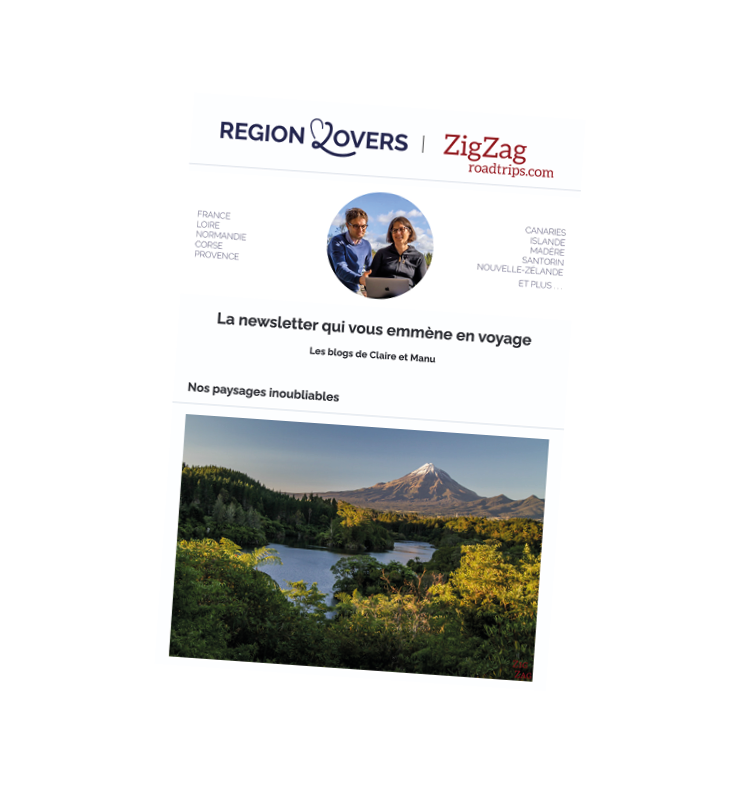The only Canadian museum of the D-Day landings, the Juno Beach Centre offers a great interactive experience covering more than just the landings: the mobilization of an army, the civilian effort, life in Canada, participation in all the battles…
Here’s our guide to planning your visit to the Juno Beach Center: the indoor museum with its various rooms and our favorite features and also Juno Park with its bunkers and equipment outside the museum.
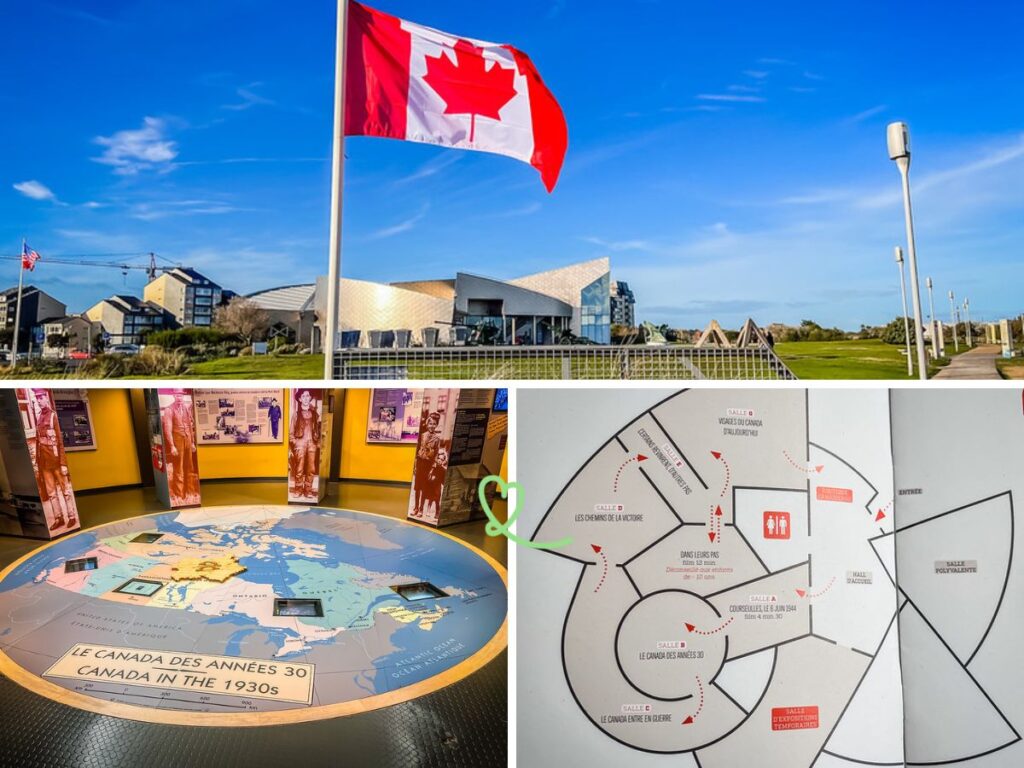
Why visit the Juno Beach Centre?
Is the Juno Beach Centre worth it? Our opinion:
Juno Beach is an excellent D-Day museum.
It honours the 45,000 Canadians who lost their lives during the Second World War, including the 381 who fell on D-Day.
It is particularly interesting for visitors with a connection to Canada.
Compared to other museums, it is less rich in weapons, clothing and other objects. But it also appeals to a wider audience thanks to its interactivity and the pace at which the content evolves from room to room.

Why is Juno Beach Centre famous?
The Juno Beach Center is one of the most important D-Day museums in Normandy.
It is very recognizable with its structure around a pentagon reminiscent of the maple leaf.
The 5 points also refer to the 5 landing beaches: Utah, Omaha, Gold, Juno and Sword.
It is known for being the museum of the Canadian landing (and for its store filled with Canadian products…lol)

Tips and Map – Juno Beach Museum, France
Where is the Juno Beach Centre?
- The museum is located in Courseulles-sur-mer, Normandy
- North of the city of Caen
- Driving time from Rouen: 01h45
- Driving time from Evreux: 02h05
- Driving time from Caen: 30min
- Driving time from Alençon: 01h40
- Driving time from Cherbourg: 01h35
- Here is a map to help you find your way:
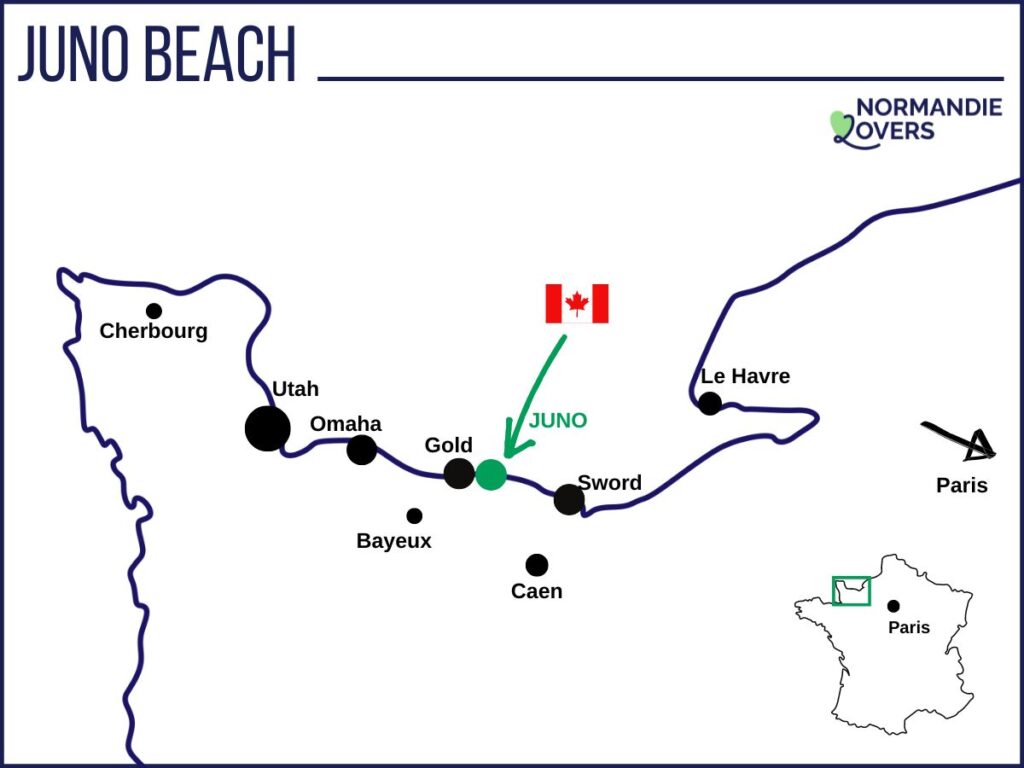
OUR ADVICE FOR RENTING A CAR IN Normandy
- Compare prices on our preferred platform: DiscoverCars – one of the best rated sites.
- Choose a car that is comfortable enough (distances can be long) but compact (some parking lots and villages are narrow).
- Think of thecomplete insurance (some roads are tortuous and narrow).
- There is a lot of demand, book it early.
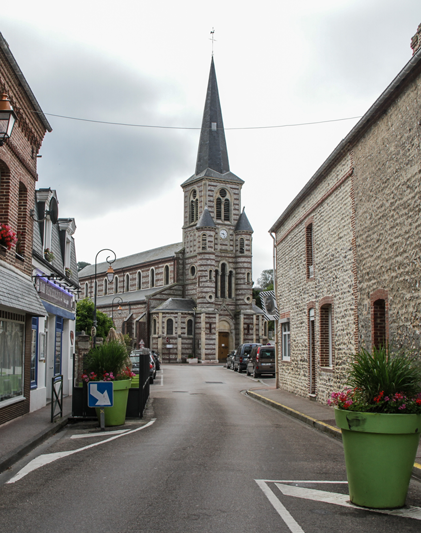
How to get there
Juno Beach is not easily accessible by public transportation.
There are 2 main options to get there:
- By car
Access is easy whether you come from Caen, Bayeux, Sword Beach or Gold Beach
And the traffic around it is also without difficulty.
The museum is well indicated. - By organized tour from Paris, Bayeux or Caen
The different tours include other landing sites: often a cemetery and a military battery
See the options - If you really want to take transportation, there are buses from Caen station and from Bayeux station. See the itineraries and schedules here.

Parking
There are 2 parking areas around the Museum.
The official parking lot is reserved for visitors to the museum (no camping).
The parking is free.
And there are a few charging stations in the parking lot.
But if you can also park before, on the side of the sailing school if you start by visiting the beach, the Lorraine cross and the open air museum.

Nearby, you will also find a bicycle parking with 6 electric terminals under cover, 2 lockers for cargo bikes,…
Best time to visit Juno Beach Centre
The museum is open all year round, except during the month of January.
It is open every day and the ticket office closes 45 minutes before closing time.
In the summer, the peak of attendance is between 10 and 11 am and between 3 and 4 pm. It is therefore preferable to visit in the early morning or late afternoon.
Visit the Juno Beach Museum: Map and Tips
The museum has a particular shape but once in front of it, the circulation is natural.
There are 7 rooms to visit, including one with a movie.
No particular advice for the direction of the visit. Follow the order of the rooms. The film lasts 12 minutes and is presented every 15 minutes.
You can also see bunkers and equipment outside around the museum.
If you have never seen one, it is better to visit the museum first to better understand.
The information is mainly in French and English.
There are toilets in the entrance of the museum.

How long to visit the museum and main difficulties
It takes 2 hours to visit the whole museum.
Longer if you are passionate and want to read a lot of the information panels.
No particular difficulties. The museum is on one floor, easy to visit and easy to navigate.
USE OUR GUIDE TO PLAN A
DREAM TRIP TO Normandy
All the information you need for your trip:
- 8 maps that make planning easier
- 160+ pre-selected locations
- Practical advice
- 300+ photos to help you choose
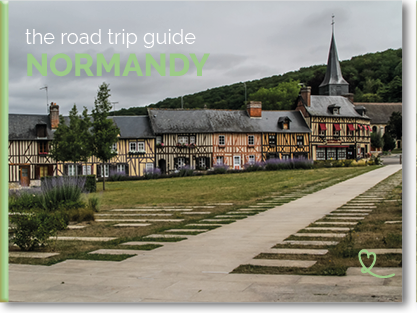
Schedules and prices
- Open from June to August from 9h30 to 19h
- Open the rest of the year at least from 10am to 5pm
- Closed on December 24 & 25 and in January.
Full adult rate: 7,50€ for the museum
For a combined ticket with a visit of the bunkers: 12€.
Free for children under 8 years old
Please note that if you come by bike, you can show a picture of your bike in the bike parking area to pay a cheaper “low carbon” ticket. A great initiative!
See the latest schedules and prices on the official website.
Guided tours

The visit of the museum is done alone.
But if you want to see Juno Park with its bunkers, the guided tour lasts 45 minutes. You enter the German command post and the observation bunker before finishing on the beach.
Visits take place in French and others in English (5 and 6 per day in July and August / 2 per day in April, May, June, September and October).
Juno Beach Centre with children
The Juno Beach Center is excellent for visiting with children.
There are a lot of interactive activities installed for them: the young public course.
- find words by turning letters,
- discover answers by opening trap doors,
- link an important person to his or her quote,
- Turning cylinders to reassemble a uniform,
- …
They can even earn “poppy points” to use at the end to learn more about Canada today.
We must admit, that even for adults, these facilities are fun. In the end, it’s easier to learn than by reading panels full of text.

Catering
There is no restaurant in the Museum.
But you are near the town of Courseulles-sur-mer where you can find restaurants.
We recommend:
- The Quai Est restaurant
Home-made and tasty food prepared by Cindy and Arnaud. They feature local and seasonal products in a refreshing setting. - The restaurant Tasting of the island
Taste seafood and oysters directly from their parks! - Chez Suzanne restaurant
By the sea, a focus on raw products in a Mediterranean style, with an emphasis on fish and shellfish.
Subscribe to our Newsletter
- Get away from it all with Region Lovers’ beautiful destinations!
- Once a month
- Advertising-free
Lodgings in the vicinity
You can find accommodation in Courseulles-sur-mer and in the surrounding countryside.
For example:
- The Hotel Ferme de la Rançonniere with beautiful stones and beams
– see prices, pictures and availability - The Manoir de Mathan hotel – not far from here, and also with beautiful buildings around an inner courtyard.
– see prices, pictures and availability
Otherwise Bayeux is only 30 minutes away.

STAYING NEAR THE D-Day beaches
Option 1: Bayeux
The most practical option, in our opinion, is to base ourselves in the town of Bayeux. We recommend..:
- Hotel Domaine de Bayeux in an 18th century mansion – see prices, photos and availability
- see all top rated accommodations in Bayeux

Option 2: in the countryside
In the countryside around the D-Day beaches, you will find beautiful buildings with a lot of charm: farms, manors…
- Hotel Domaine d’Utah Beach – prices, pictures and availability
- Hotel Ferme de la Rançonnière – prices, pictures and availability

Option 3: next to one of the beaches
If you’re looking for a seaside holiday or are fascinated by one of the beaches, you can choose a more specific hotel:
- Hotel Villas d’Arromanches in Gold Beach Beach – prices, pictures and availability
- Hotel La Sapinière in Omaha Beach Beach – prices, pictures and availability

Room A – the landing barge

The tour begins with a film of less than 5 minutes that can be viewed by children of all ages. There is no voice, it can be viewed in any language.
The room is shaped like a stylized landing barge.
The film includes footage of the war, troop training, D-Day and Canada during the war.
Nearly 14,000 Canadian soldiers landed on Juno Beach Beach alongside British soldiers. All volunteers, they arrived by sea in these oppressive barges.
Room B – Canada in the 1930s

In the next room, you will discover Canada in the 1930s, before the war.
In the center the circular map is 5 meters wide. You can thus better visualize the Canadian territory. And you can have fun comparing the size of France with the size of Canada!
The different arches focus on different aspects of the country at that time: political, social, geographical, economic, demographic, military…
Its army was very small and at the beginning of the war, the government took a position in favor of a policy of appeasement.
Room C – the constitution of the armed forces

This room focuses on the formation of an army.
MacKenzie King declared a state of war with Germany on September 1, 1939.
The whole country was mobilized:
- on the military side with the infantry, navy and air force
- on the civilian side with the war effort and the financing
Note the soldiers’ pay books displayed in one of the showcases.
More than 450,000 Canadians volunteered to fight overseas.

You will also find models of ships:
- The Flower Class Corvette
- The River Class Frigate
- The Tribal Class Destroyer
- The Bangor-class Mine Digger
and aircraft of the Canadian Army:
- The Hawker Typhoon
- The Auro Lancaster
- The Hawker Hurricane
- The Supermarine Spitfire
- The Canso

And in terms of the war effort, we were particularly interested in:
- posters for metal and paper collection
- examples of the use of steel, aluminum and rubber for warfare
- information on children’s volunteer work because of the lack of manpower with the men away at the front

Room D – the roads to victory
In this room, we go into the details of the military campaigns and how they led to victory.
This covers:
- The battle of Italy
- The Battle of Normandy
- The Battle of the Scheldt
- The Battle of Rehnania
- The victory
This covers the soldiers and the strategy but also the other resources necessary for the victory: nurses, journalists, stewardship, civil engineering… For one soldier at the front, 5 support people were needed behind.

We were particularly interested in:
- the badges of the various trades
- examples of soldiers’ uniforms
- the necessities of the soldiers to live in the trenches: shaving, sewing his clothes, eating…

MORE ABOUT THE D-Day sites
- The best landing sites to visit
- Visit the 5 D-Day landing beaches
- Where to stay – best hotels near the beach
- The best D-Day museums in Normandy
- German batteries to visit
- Car rental tips: Caen – Roissy-CDG – Orly – Beauvais
- Visit Omaha Beach
- Visit Utah Beach
- Visit Gold Beach
- Visit Sword Beach
- Visit Juno Beach (coming soon)
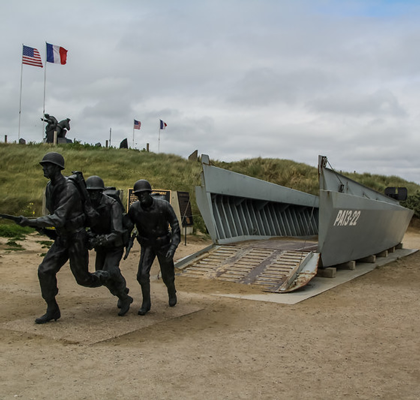
Room E – some came back, some did not…
The next room is much more solemn.
It traces the human toll of the Second World War on Canadians.
During the war, 45,000 of them died.
This room scrolls their names.
And you can also sit and listen to the reading of letters written by the soldiers.

Room F – film “In Their Footsteps
Then you have the option of seeing the film “In Their Footsteps3.
It lasts 12 minutes. There are 62 seats.
This film is not recommended for children under 10 years old. There are brutal images of war.
We enjoyed this film very much as it gave a glimpse of the battle of the Canadian troops without going on too long. It is a good introduction to get a little more insight into the conditions the soldiers endured.
It is in English sub-translated into French and in French sub-translated into English depending on the passages.

Room G – Face of Canada Today
The last room, which is flooded with light, presents Canada today.
24 Canadian personalities tell their story and discover the Canada of today.
you will learn more about natural resources, cities, provinces, legends… and maple syrup!

The Canadian Store
The tour ends with the souvenir store.
This is one of the nicest of all the D-Day museums because you can also find typical Canadian products:
- Beers
- Maple syrup (70% of the production comes from Canada)
- Maple syrup products
- Accessories with the maple leaf or the word Canada

Around the museum
All around the museum there is more to see.
Everything is open access except the inside of the bunkers.
Commemorative bricks

Just in front of the museum entrance find inverted pyramids with thousands of plates. They were purchased by donors to be dedicated to Canadians who served in the First or Second World War.
The sculpture “The Reanimated Memory”.

In front of the museum, you can’t miss the sculpture. It calls out!
This is a work by Canadian artist Colin Gibson. 5 soldiers gather and look into the distance.
The forms are wavy to form one, representing the union of those who have served Canada.
Yuksuk

The Inuksuk is a symbol of survival for the Inuit in Canada. It is also a guide that testifies to the passage of humans in this place.
It was erected by Inuit Peter Irniq in 2005.
Juno Park with bunker and artillery
Juno Park between the sand dunes and the museum offers other interesting things to discover:
- Mark II rapid fire guns
- The German underground command post
- a covered trench,
- beach obstacles (tetrahedrons) set up to prevent the landing of vehicles, mainly tanks.

Juno Beach Beach and its dunes

Juno Beach Beach is a long sandy beach.
It is limited by sand dunes.
The dunes on the sea side are mobile. They are constantly being reshaped by the elements. Only very resistant plants can survive.
While on the land side, the dune is fixed in part due to the installed vegetation. The animals find refuge there, and biodiversity is more important.
The Cross of Lorraine and other memorials

A little further along the dunes, you will see floats and memorials.
Among others:
- The Lorraine cross was erected facing the sea to commemorate the arrival of General de Gaulle on French soil after 4 years of exile. It is a double cross of more than 18m high.
- The Polish Memorial
- The memorial of Graye-sur-mer with the 7th Candian brigade
PLAN YOUR TRIP TO Normandy
Inspiration destinations
- Deciding where to go in Normandy – the best destinations
- Our weekend ideas: best-of, romantic, unusual, seaside, luxury, family
- 16 seaside hotels in Normandy
- The most beautiful charming hotels in Normandy

Best of

Practice
- Where to stay in Normandy – best places and hotels
- See our tips for renting a car at CDG airport, Orly airport, Beauvais airport, Caen, Rouen, Bayeux…

Near Juno Beach Beach
There are fascinating sites all along the Normandy coast.
And within a 30 minute drive you have plenty to visit to complete your World War II experience.
The cemetery of Beny-sur-Mer

A 10-minute drive inland, you can visit the Canadian cemetery at Beny-sur-Mer. 1694 soldiers and 15 Canadian airmen are buried there, including 335 soldiers of the 3rd division.
Most were killed during D-Day and the battle of Caen.
Free access
The British Memorial

In Ver-sur-Mer, the British Normandy Memorial is also a beautiful place to visit.
Only a 10-minute drive from Juno, it is free to use but parking is charged.
Statues, names of soldiers, and memorials facing the sea.
Dover-la-Délivrandes and the Radar Museum

At 15min inland you can see Douvres-la-Délivrandes with its basilica with 2 bell towers which was a landmark for the landing troops.
In this city is the Franco-Alleman Radar Museum where you can learn more about the 44th radar station, the radars of that time and enter bunkers.
Gold Beach (Arromanches-les-Bains)

And 20min along the coast, you can reach the town of Arromanches-les-Bains which was Gold Beach.
This is where the temporary Mulberry Ports were set up. There are still pieces of it, it’s quite impressive. This is our favorite beach to visit.


